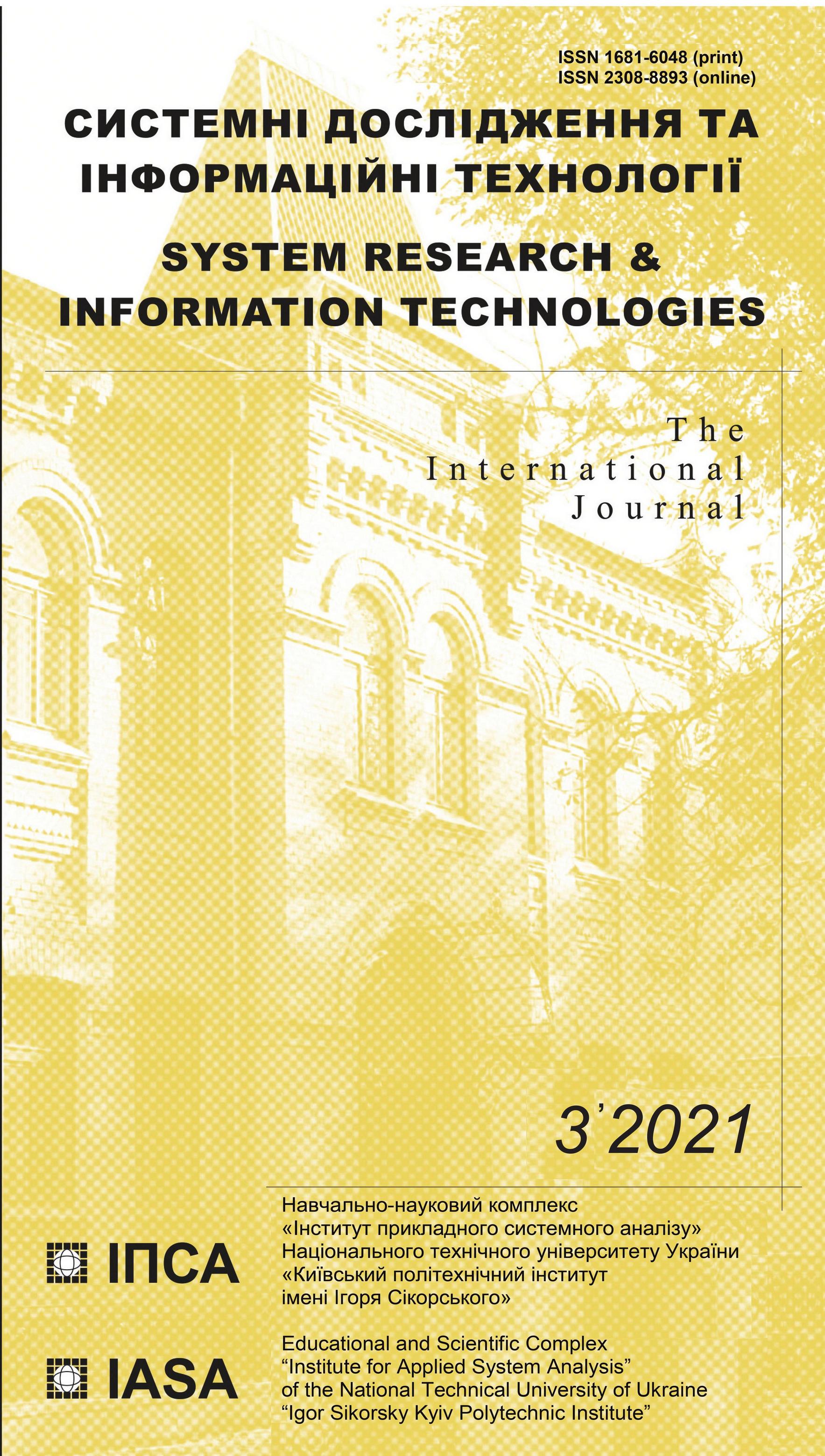Solving the problem of mathematical models overparameterization for some nonlinear oscillating systems
DOI:
https://doi.org/10.20535/SRIT.2308-8893.2021.3.11Keywords:
time series, original system, differential model, numerical method, analytical methodAbstract
This study proposes a numerical-analytical method that allows us to simplify the model, which is obtained on the basis of the single observable variable of an object under the study, and which may be overparameterized. As a model, we consider a system of ordinary differential equations with polynomial right-hand sides. To solve this problem, the so-called differential model is used, that is, a system in which unknown variables are replaced by derivatives of the observed variable, and which is derived on the basis of a system under the study so that the observed variables of these systems coincide. The method of simplification of a system under the study is based on the fact that using a numerical method, a simpler differential model can be obtained. Next, an analytical transition from a simplified differential model to a simplified original system is performed. In this case, the time series error remains within given limits even for systems with deterministic chaos, despite their high sensitivity to the initial conditions.
References
T. Bohlin, Practical grey-box process identification: Theory and applications. London: Springer-Verlag, 2006, 351 p.
X. Hong, R.J. Mitchell, S. Chen, C.J. Harris, K. Li, and G.W. Irwin, “Model selection approaches for non-linear system identification: a review”, International Journal of Systems Science, 39, no. 10, pp. 925–946, 2008.
S. Chen, S.A. Billings, and W. Luo, “Orthogonal Least Squares Methods and their Applications to Nonlinear System Identification”, International Journal of Control, 50, pp. 1873–1896, 1989.
J. Cremers and A. Hübler, “Construction of differential equations from experimental data”, Naturforsch, 42 (a), pp. 797–802, 1987.
J.L. Breeden and A. Hübler, “Reconstructing equations of motion from experimental data with unobserved variables”, Phys. Rev. A, 42, pp. 5817–5826, 1990.
G. Gouesbet, “Reconstruction of the vector fields of continuous dynamical systems from numerical scalar time series”, Phys. Rev. A, 43, pp. 5321–5331, 1991.
U. Parlitz, “Estimating Model Parameters from Time Series by Autosynchronization”, Physical review letters, 76, no. 8, pp. 1232–1235, 1996.
G. Rowlands and J.C. Sprott, “Extraction of dynamical equations from chaotic data”, Physica D, 58, pp. 251–259, 1992.
G.L. Baker, J.P. Gollub, and J.A. Blackburn, “Inverting chaos: Extracting system parameters from experimental data”, Chaos, 6, no. 4, pp. 528–533, 1996.
C. Letellier, L.Le. Sceller, E. Maréchal, P. Dutertre, B. Maheu, and G. Gouesbet, “Global vector field reconstruction from a chaotic experimental signal in copper electrodissolution”, Physical review E, 51, pp. 4262–4266, 1995.
G.K. Vallis, “Conceptual models of El Niño and southern oscillations”, Journal of geophysical research, 93, no. 11, pp. 13979–13991, 1988.
E.N. Lorenz, “Deterministic nonperiodic flow”, J. Atmos. Sci., 20, pp. 130–141, 1963.
D. Gurel and O. Gurel, Oscillations in chemical reactions. Springer, 1983, 124 p.
I.-C. Chou and E.O. Voit, “Recent developments in parameter estimation and structure identification of biochemical and genomic systems”, Mathematical Biosciences, 219, pp. 57–83, 2009.
S. Mangiarotti, L. Drapeau, and C. Letellier, “Two chaotic global models for cereal crops cycles observed from satellite in northern Morocco”, Chaos, 24, 023130, 2014.
S. Mangiarotti, M. Peyre, and M. Huc, “A chaotic model for the epidemic of Ebola virus disease in West Africa (2013–2016)”, Chaos, 26, 113112, 2016.
L.F.P. Franca and H.I. Weber, ”Experimental and numerical study of a new resonance hammer drilling model with drift”, Chaos, Solitons and Fractals, 21, pp.789–801, 2004.
C. Liu, D. Qin, J. Wei, and Y. Liao, “Investigation of nonlinear characteristics of the motor-gear transmission system by trajectory-based stability preserving dimension reduction methodology”, Nonlinear Dyn., 94, pp. 1835–1850, 2018.
W. Horbelt, J. Timmer, M.J. Bünner, R. Meucci, and M. Ciofini, “Dynamical modelling of measured time series from a Q-switched CO2 laser”, Chaos, Solitons and Fractals, 17, pp. 397–404, 2003.
L.A. Aguirre and C. Letellier, “Modeling nonlinear dynamics and chaos: A review”, Mathematical Problems in Engineering, 238960, 2009.
L.A. Aguirre and S.A. Billings, “Dynamical effects of overparametrization in nonlinear models”, Physica D, 80, pp. 26–40, 1995.
E.M.A.M. Mendes and S.A. Billings, “On overparametrization of nonlinear discrete systems”, International Journal of Bifurcation and Chaos, 8, no. 3, pp. 535–556, 1998.
G. Olsson and G. Piani, Computer systems for automation and control; 2nd edition. Prentice Hall International (UK) Ltd., London, 1998, 497 p.
G. Gouesbet, “Reconstruction of standard and inverse vector fields equivalent to the Rössler system”, Phys. Rev. A, 44, pp. 6264–6280, 1991.
J. Maquet, C. Letellier, and L.A. Aguirre, “Scalar modeling and analysis of a 3D biochemical reaction model”, Journal of theoretical biology, 228, pp. 421–430, 2004.
C. Lainscsek, C. Letellier, and F. Schürrer, “Ansatz library for global modeling with a structure selection”, Phys. Rev. E, 64, 016206, pp. 1–15, 2001.
C. Lainscsek, “A class of Lorenz-like systems”, Chaos, 22, 013126, 2012.
V. Gorodetskyi and M. Osadchuk, “Analytic reconstruction of some dynamical systems”, Phys. Lett. A, 377, pp. 703–713, 2013.
C. Lainscsek, C. Letellier, and I. Gorodnitsky, “Global modeling of the Rössler system from the z-variable”, Phys. Lett. A, 314, pp. 409–427, 2003.
V. Gorodetskyi and M. Osadchuk, “Simplification of a reconstructed model”, International Journal of Dynamics and Control, 7 (4), pp. 1213–1224, 2019.
J.C. Sprott, Elegant chaos. Algebraically simple chaotic flows. Singapore: World Scientific Publishing Co. Pte. Ltd., 2010, 285 p.

